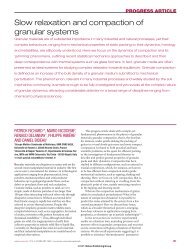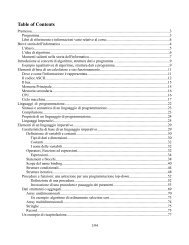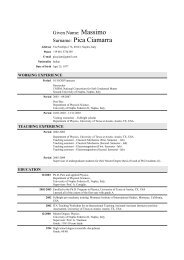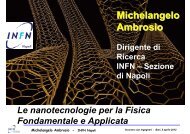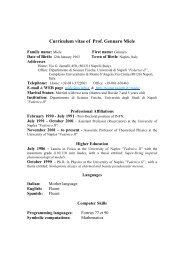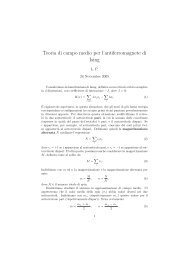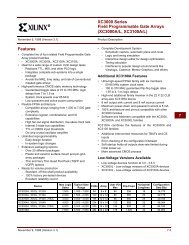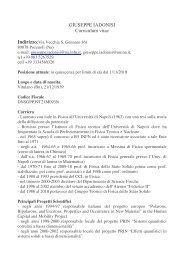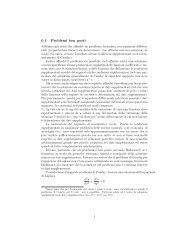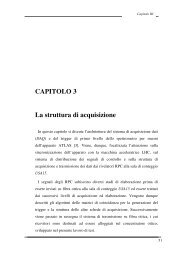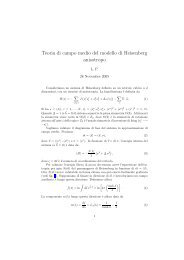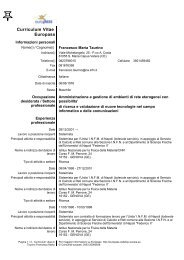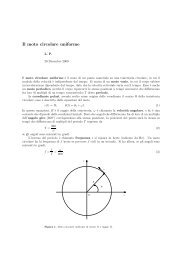Phys Rev E
Phys Rev E
Phys Rev E
Create successful ePaper yourself
Turn your PDF publications into a flip-book with our unique Google optimized e-Paper software.
MANZO et al. PHYSICAL REVIEW E 73, 051707 2006<br />
dn<br />
= t nt. 22<br />
dt<br />
Since the orientation of the average director of the droplet in<br />
the xy plane is given by the angle introduced in the previous<br />
section, one also has z=d/dt.<br />
As with all rigid bodies, all one needs in order to determine<br />
the droplet rotational dynamics is Eq. 12 for the angular<br />
momentum rate of change, as applied to the entire<br />
droplet volume V=V d. By introducing Eqs. 21 and 22 in<br />
Eq. 13, the total angular momentum of the droplet can be<br />
rewritten as<br />
L = I, 23<br />
where I is the total moment of inertia, given by I= Vd x 2<br />
+y 2 dV=2mR 2 /5, and we have neglected I n.<br />
The total external torques M acting on the droplet can<br />
be computed more conveniently using their surface integral<br />
expression, Eq. 15. As already discussed in the previous<br />
section, the surface integral can be actually evaluated on a<br />
surface that lies just outside the liquid crystal droplet boundary,<br />
i.e., within water, thereby making the calculation much<br />
simpler. Let us now consider each of the five contributions<br />
=hp,el,vis,em,ph.<br />
First, owing to the spherical shape of the droplet within<br />
the SDA, the pressure torque M hp will vanish identically, as<br />
it can be readily verified by a direct calculation. Since in<br />
water there are no elastic stresses, the elastic torque M el will<br />
also vanish identically.<br />
The viscous term does not vanish and it can be easily<br />
evaluated by solving the Navier-Stokes equations in water<br />
with assigned velocity on the droplet boundary as given by<br />
Eq. 21 in the laminar flow limit and neglecting the effect<br />
of the electromagnetic stresses in water. The result of such<br />
calculation is the well-known Stokes formula for the rotational<br />
viscous torque acting on a rotating sphere in a viscous<br />
fluid:<br />
M vis =−6V d, 24<br />
where is the water viscosity coefficient.<br />
The electromagnetic torque M em does not vanish. Within<br />
the PSA approximation discussed above, its z component<br />
will be given by Eq. 18, while its x and y components will<br />
vanish.<br />
Finally, as already discussed in the previous section, the<br />
photoinduced torque M ph should also vanish based on our<br />
theory, as in water there should be no photoinduced stresses.<br />
However, as discussed above, we cannot exclude that a<br />
higher-order theory might predict a nonvanishing M ph associated<br />
to interfacial effects a specific possibility for such an<br />
effect would be, for example, a photoinduced discontinuity<br />
of the flow velocity at the boundary between liquid crystal<br />
and water. Therefore we should consider this possibility in<br />
our analysis.<br />
Neglecting inertial terms, Eq. 12 in the RBA model is<br />
then reduced to the following torque balance:<br />
051707-6<br />
Mvis + Mem + Mph =0, 25<br />
where the first two torques are given by Eqs. 24 and 18,<br />
while the expression of Mph is unknown. Equation 25 is<br />
actually a first-order differential equation in the rotational<br />
angle t.<br />
Let us assume initially that Mph =0. As discussed in the<br />
previous section, the steady-state solution of Eq. 25 depends<br />
on the value of the polarization ellipticity s3 with<br />
respect to the threshold value s3t given in Eq. 19. For<br />
s3 s3t the solution is static, i.e., t= 0 is constant, while<br />
for s3 s3t the solution is dynamical and corresponds to a<br />
generally nonuniform rotation of the droplet around the z<br />
axis. In the circular polarization limit the rotation becomes<br />
uniform.<br />
By a simple integration, it is possible to determine the<br />
overall rotation frequency f of the droplet, which takes the<br />
following expression:<br />
where<br />
f = f 0 Res 3 2 1−e −2 0 R cos 2<br />
− 1−s 3 2 e −4 0 R sin 2 1/2 , 26<br />
f0 = P0/162R3 27<br />
note that Eq. 26 includes also the stationary solutions<br />
f =0, for s3s 3t. The highest frequency is obviously<br />
reached for s3= ±1, i.e., for circular polarization of the input<br />
light. Note also that if we take the 0→ limit which may<br />
be actually due to all the factors discussed above and neglected<br />
in PSA, we obtain simply f = f0 instead of Eq. 26.<br />
Let us now consider what should happen instead for<br />
Mph0. As we said, we do not know the actual expression<br />
of a nonvanishing Mph , as this should result from some unknown<br />
higher-order term in the constitutive equations. However,<br />
since the photoinduced torque density ph acting on the<br />
molecular director is proportional to the electromagnetic one<br />
em , it is reasonable to expect that also this photoinduced<br />
torque Mph is proportional to Mem . The ratio of the photoinduced<br />
to electromagnetic torque density is / a, a number<br />
which is of the order of several hundreds. The corresponding<br />
ratio of total external torques is therefore limited by this<br />
value, although it could be smaller.<br />
In the case of circularly polarized input light, the effect of<br />
the photoinduced external torque would be that of inducing a<br />
dye-enhanced droplet rotation, as revealed by a higher rotation<br />
frequency achieved for the same input light power, or a<br />
smaller light power needed to obtain the same rotation frequency<br />
when compared with the undoped case or to what<br />
happens when light falling outside the dye absorption band is<br />
used. In the experimental section we will specifically search<br />
for such effects.<br />
C. Uniform director approximation (UDA)<br />
According to the RBA model presented in the previous<br />
section, the rotation speed of a droplet is independent of all<br />
photoinduced effects, unless higher-order interfacial effects<br />
should be found to be significant. This conclusion relies<br />
strongly on the assumption that the droplet rotates effectively



